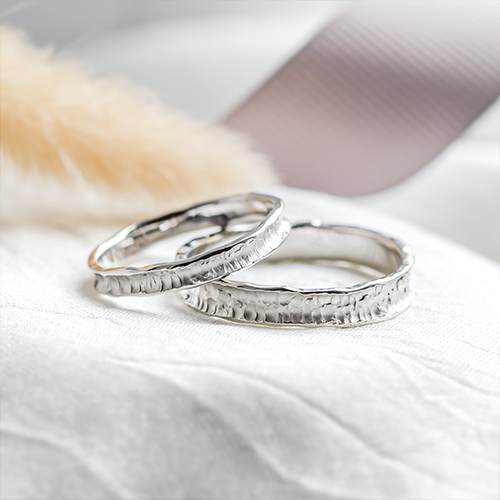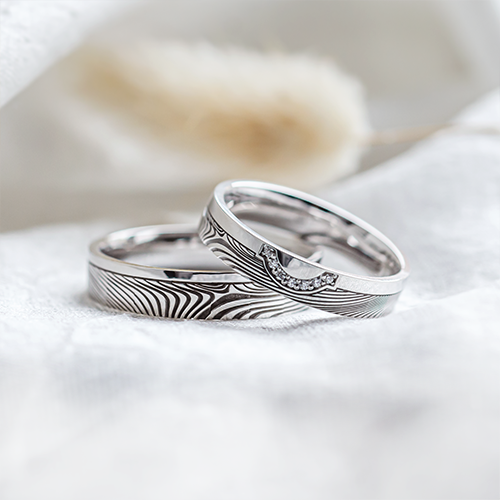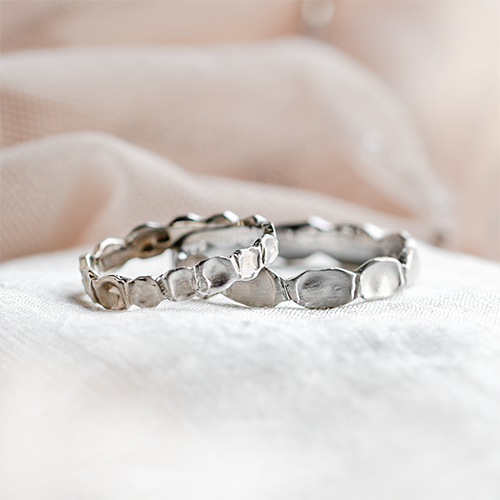Gold vs. platinum: Everything you should know before choosing wedding and engagement rings
Are you faced with a jewellery choice you don't know what to do with? If you've fallen in love with white metals and are thinking about platinum and white gold, read on. Both metals have their own unique properties, so in this article we'll compare platinum vs gold. We'll tell you what their advantages and disadvantages are. And why platinum is more expensive than gold. So let's do it! Whether you're choosing jewellery for a wedding, engagement, or looking for a special birthday gift, these jewels could be the perfect choice for you. Thanks to their white colour, they represent pure elegance. They sparkle beautifully, match any gemstone and harmonise with any style. Although they may look indistinguishable at first glance, they have different characteristics. Therefore, it is important to choose between them carefully, taking into account the specific characteristics of each metal and also taking into account the preferences of the person who will wear the jewellery. Gold has a very rich tradition in the history of jewellery making and continues to grow in popularity. Even today, gold jewellery is the most popular staple not only among jewellers but also among customers. Gold enchants them with its shine, its wide price range and its range of colours. Here you can choose from all three colours, classic yellow, romantic rose or elegant white. White gold is visually similar to platinum, so the question often arises whether to choose white gold or platinum for jewellery. If you would like to invest in more valuable jewellery, platinum wedding rings may be ideal. This is a high-shine precious metal, of which only a few hundred tonnes are mined each year. Its rarity adds to its attractiveness, which is of course reflected in its price. Compared to gold, however, platinum does not have such a strong tradition on the market and its popularity has only risen a few years ago.Popular white metal pieces
Gold jewellery always impresses
For the demanding, there's platinum jewellery
|
|
|
Platinum vs. gold
Which is more expensive, platinum or gold? And how exactly do they differ? We've compiled a list of some basic parameters that will tell you how these two metals differ.
Colour
Platinum and white gold: Both metals in their final form are characterised by their white colour and silvery lustre, providing a clean, elegant look that suits the combination with any gemstone. However, if you do want to compare the colours, on closer observation the trained eye may notice that platinum has a slightly darker shade. If you are more of a layman, however, you will most likely not be able to tell the difference.
Composition of metal
Platinum: It is used in jewellery making in an almost pure form. Because of its softness, however, a small presence of other metals such as palladium or cobalt is necessary.
White gold: White gold does not exist in nature. To achieve a white colour, the metal is formed by alloying pure gold with palladium or nickel, for example.
Price
Platinum: It is usually more expensive than white gold, which is mainly due to its rarity and difficulty in processing. In order to make platinum jewellery more durable, it is made more massive, so the price also increases with the higher weight.
White gold: This is a more affordable metal than platinum. If you don't see jewelry as a big investment and are looking for a more economical option, white gold may be right for you.
Resistance
Platinum: It would seem that platinum is more durable because it is hard in its pure form. But don't be fooled, it is only used as an alloy in jewellery making it softer than white gold. To keep you company for the rest of your life, luxury jewellery made from platinum is made more robust. Still, you need to keep an eye on them as they can still get scratched.
White gold: Its hardness decreases with increasing carats and it becomes significantly softer. After a few years, this can lead to deformation or light scratching. But it always depends on how careful you are with your jewellery.
|
|
|
Allergenicity
Platinum: It is hypoallergenic, which is appreciated by people who suffer from metal allergies.
White gold: In the case of white gold, it depends on the alloying metal in the alloy. This is because some can cause allergic reactions in sensitive individuals. Although many people think they are allergic to gold, it is actually nickel, zinc, copper or silver that is behind the adverse reactions.
The surface of jewellery
Platinum: Due to its extreme durability, platinum holds its colour. This gives it a significant advantage over gold – even over the years, the surface does not need to be treated in any special way.
White gold: Because this metal is not naturally white, it has to be rhodium-plated during production. Over time, this surface can fade and must be reapplied to prevent subtle yellowing. However, if you are a fan of the natural shades of white gold, we can make your jewellery without rhodium on request and you can enjoy original white gold jewellery with warm shades.
Use in the jewellery industry
Platinum: It is often used for jewellery where high durability is required, which is why customers choose it for engagements or weddings.
White gold: Gold is simply a popular classic. Here you can choose gold wedding rings and engagement rings, as well as necklaces, bracelets or earrings for special events and everyday wear.








